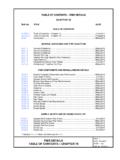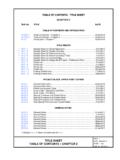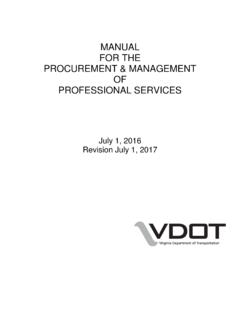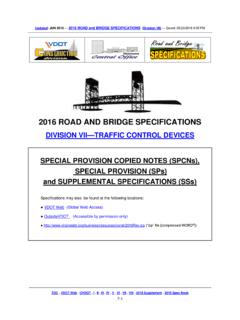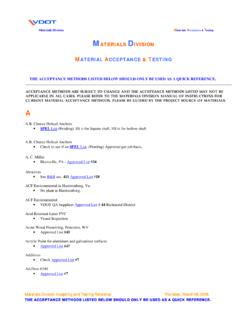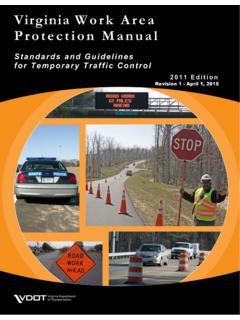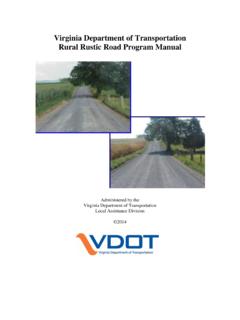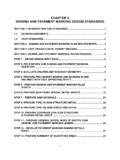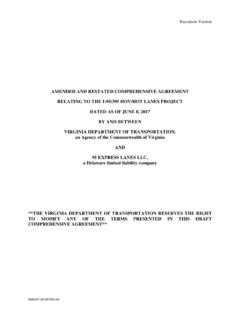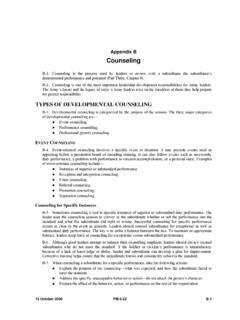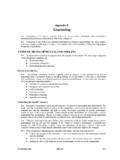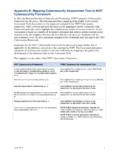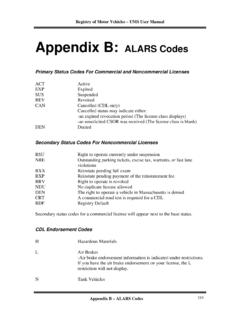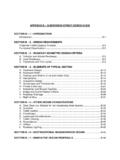Transcription of APPENDIX B – SUBDIVISION STREET DESIGN GUIDE
1 APPENDIX B SUBDIVISION STREET DESIGN GUIDE . SECTION B 1 INTRODUCTION ..B-1. Introduction ..B-1. SECTION B 2 DESIGN REQUIREMENTS ..B-2. Projected Traffic/Capacity Functional Classification ..B-2. Terrain ..B-4. SECTION B 3 ROADWAY GEOMETRIC DESIGN A. Collector and Arterial Roadways ..B-5. B. Local Roadways ..B-5. C. Transitions and turn lanes ..B-6. D. Sight Distance ..B-11. SECTION B 4 ELEMENTS OF TYPICAL SECTION ..B-13. A. Pavement B. Pavement Width ..B-13. C. Parking lane widths (curb and gutter only) ..B-14.
2 D. Intersections ..B-14. E. Concentric F. Cul-de-sacs and turnarounds ..B-16. G. Curb and gutter designs ..B-19. H. Private I. Pedestrian and Bicycle Facilities ..B-24. J. Bridge and culvert DESIGN criteria ..B-28. K. Roadway Drainage ..B-28. L. Right-of-way ..B-31. SECTION B 5 OTHER DESIGN CONSIDERATIONS ..B-32. A. Clear Zone ( Setback for non-breakaway fixed objects) ..B-32. B. C. Traffic D. Streetscape ..B-34. E. Landscape F. Traffic Calming ..B-38. G. Roundabouts ..B-40. H. I. Roadway Lighting ..B-44. SECTION B 6 NEOTRADITIONAL NEIGHBORHOOD DESIGN .
3 B-46. SECTION B 7 INNOVATIVE DESIGN List of Tables Geometric DESIGN Standards for Residential SUBDIVISION Streets Table 1 Curb And Gutter Section ..B-7. Table 2 Shoulder And Ditch Table 3 One-Lane (One-Way) SUBDIVISION Streets ..B-9. Table 4 - school bus access 10. Table 5 - maximum Grade Lengths for Shared Use List of Figures Figure 1 - "Exhibit 2-4" scanned from "A Policy on Geometric DESIGN of Highways and Streets, AASHTO, 2001 ..B-5. Figure 2 Sight Distance Triangles ..B-12. Figure 3 Intersection DESIGN .
4 B-15. Figure 4 Cul-de-sac details ..B-18. Figure 5 Curb and Gutter Details ..B-19. Figure 6 Detail back of Figure 7 - Roll top curb entrance detail ..B-22. Figure 8 Rolltop curb entrance detail section ..B-22. Figure 9 Private Entrance Detail ..B-23. Figure 10 - Setback Details with Curb and Gutter ..B-33. Figure 11 Setback Details with Shoulder and Ditch ..B-33. Figure 12 Traffic Calming Details ..B-39. Figure 13 Roundabout details ..B-42. Figure 14 Lighting along Curb and Gutter Sections ..B-45. Figure 15 Lighting along Shoulder and Ditch Figure 16 - Curb Extension Detail.
5 B-47. B-1. APPENDIX B SUBDIVISION STREET DESIGN GUIDE . SECTION B 1 INTRODUCTION. INTRODUCTION. This document is an APPENDIX of VDOT's Road DESIGN Manual and is intended for users of VDOT's SUBDIVISION STREET Requirements for the development of new SUBDIVISION streets functionally classified as local streets. All other streets must be developed in accordance with appropriate provisions of the Road DESIGN Manual for the appropriate functional classification. For the purposes of this document, Resident Engineer means that employee who oversees the land development functions for the residency.
6 This may be the Resident Engineer, Residency Administrator or that employee designated to perform the responsible charge duties for the residency or other designee as determined by the District Administrator. In the context of this document, the term can also refer to A. In Districts having centralized functions, it means the Land Development Manager, Residency Permit manager or that employee designated to oversee land development functions. B. In cities or towns choosing to use this DESIGN GUIDE for the DESIGN of their SUBDIVISION streets, it means the local official responsible for the review and approval of SUBDIVISION STREET DESIGN .
7 In the event of conflict between this APPENDIX and other provisions of the Road DESIGN Manual, Road and Bridge Standards, and the SUBDIVISION STREET Requirements, the Resident Engineer shall determine the governing provision. As indicated in the SUBDIVISION STREET Requirements, any requirements of the SUBDIVISION ordinance of the locality that are greater than these requirements shall govern. The Resident Engineer is provided considerable discretionary authority in the application of standards related to local SUBDIVISION streets.
8 The district administrator is authorized to consider and render a decision on unresolved issues between the developer and the resident engineer that pertain to the interpretation and application of this APPENDIX . All appeals shall be made in writing describing the unresolved issue and include copies of all prior relative correspondence. All land development proposals should be submitted to the local jurisdiction, which will then coordinate with the local Resident Engineer or Northern Virginia District's Land Development Section for VDOT review and approval.
9 The Resident Engineer or Land Development Office will coordinate with other VDOT sections as needed. B-2. SECTION B 2 DESIGN REQUIREMENTS. PROJECTED TRAFFIC/CAPACITY ANALYSIS. For the purposes of these requirements, "projected traffic" includes the traffic resulting from the complete development of all land to be served by the subject roadway facility, including traffic forecast to be generated by development, both internal and external, to the SUBDIVISION under consideration. The basis for this forecast will be the governing body's current comprehensive plan or other available information pertinent to the permitted land use and transportation planning for the SUBDIVISION and adjacent properties.
10 The trip generation rates in the current version of Trip Generation, published by the Institute of Transportation Engineers (ITE) should be utilized in determining the projection of traffic. The ITE trip generation rate for a single-family detached residential dwelling unit is currently 10. vehicle trips per day. The use of other bona fide traffic studies in determining projected traffic for all types of land development may be considered, subject to their submission for review and approval by the department.
